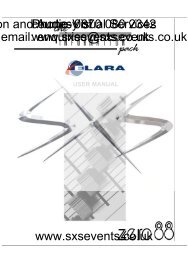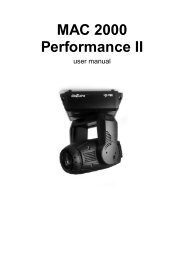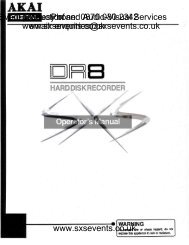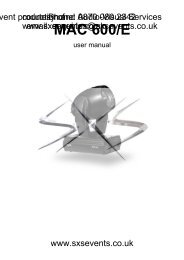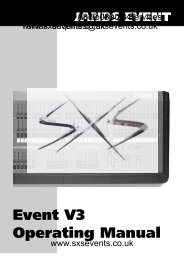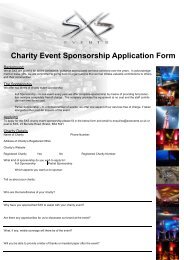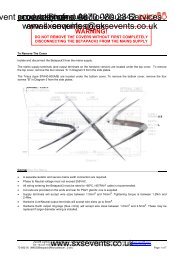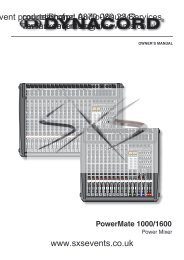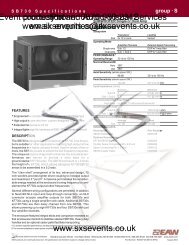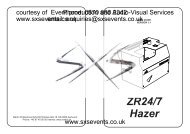Rigging - CM Lodestar Manual - SXS Events
Rigging - CM Lodestar Manual - SXS Events
Rigging - CM Lodestar Manual - SXS Events
You also want an ePaper? Increase the reach of your titles
YUMPU automatically turns print PDFs into web optimized ePapers that Google loves.
vent courtesy production V! Phone: WARNING of and 0870 Audio-Visual 080 2342 V! WARNING Services<br />
www.sxsevents.co.uk<br />
email: enquiries@sxsevents.co.uk<br />
Allowing the hook block to run into the bottom of the hoist<br />
when raising a load or allowing the chain to become taut<br />
between the loose end screw and the frame when lowering<br />
a load may break the chain and allow the load to drop.<br />
TO AVOID INJURY:<br />
Do not allow the hook block to contact the bottom of the<br />
hoist or the loose end chain to become taut.<br />
Do not force the <strong>Lodestar</strong> Protector to compensate for<br />
improperly adjusted limit switches or reverse voltage phasing.<br />
Failure to properly ground the hoist presents the danger of<br />
electric shock.<br />
TO AVOID INJURY:<br />
Permanently ground the hoist as instructed in this manual.<br />
Low voltage may also be caused by using an undersized<br />
cord and/or connectors to supply power to the hoist. The following<br />
chart should be used to determine the size wires in<br />
the extension cord in order to minimize the voltage drop<br />
between the power source and the hoist.<br />
CHECKING FOR TWIST IN LOAD CHAIN Models R, RR<br />
The best way to check for this condition is to run the lower<br />
hook, without a load, up to within about 2 feet (.61 Meters) of<br />
hoist. If the dead end of the chain has been properly installed,<br />
a twist can occur only if the lower hook block has been capsized<br />
between the strands of chain. Reverse capsize to<br />
remove twist.<br />
CHECKING FOR ADEQUATE VOLTAGE AT HOIST<br />
The hoist must be supplied with adequate electrical power in<br />
order to operate properly. For proper operation, the voltage,<br />
(measured at the hoist end of the standard power cord with<br />
the hoist operating in the , up direction with full load) must<br />
be as indicated in the table below.<br />
LENGTH<br />
OF<br />
EXTENSION<br />
CORD<br />
UP TO 50 FEET<br />
80 FEET<br />
(24.4 M)<br />
120 FEET<br />
(36.7 M)<br />
THREE<br />
PHASE<br />
HOISTS<br />
MINIMUM<br />
WIRE SIZE<br />
#16 AWG<br />
(1.6 mm)<br />
#16 AWG<br />
(1.6 mm)<br />
#14 AWG<br />
(2.0 mm)<br />
NOMINAL<br />
CURRENT<br />
MINIMUM<br />
RUNNING<br />
VOLTAGE<br />
MINIMUM<br />
STARTING<br />
VOLTAGE<br />
230-3-60 187 -<br />
460-3-60 396 -<br />
220-3-50 198 -<br />
380-3-50 365 -<br />
415-3-50 399 -<br />
SIGNS OF INADEQUATE ELECTRICAL POWER<br />
(LOW VOLTAGE) ARE:<br />
• Noisy hoist operations due to brake and/or contactor<br />
chattering.<br />
• Dimming of lights or slowing of motors connected to<br />
the same circuit.<br />
• Heating of the hoist motor and other internal components<br />
as well as heating of the wires and connectors<br />
in the circuit feeding the hoists.<br />
• Failure of the hoist to lift the load due to motor stalling.<br />
• Blowing of fuses or tripping of circuit breakers.<br />
To avoid these low voltage problems, the hoist must be connected<br />
to an electrical power supply system that complies<br />
with the National Electrical Code and applicable local codes.<br />
This system must also provide (slow blow fuses or inversetime<br />
type circuit breakers) and provisions for grounding the<br />
hoist.<br />
200 FEET<br />
(61.0 M)<br />
300 FEET<br />
#14 AWG<br />
(2.0 mm)<br />
#12 AWG<br />
(91.4 M)<br />
(2.7 mm)<br />
For runs beyond 300 Feet contact factory.<br />
V!<br />
www.sxsevents.co.uk<br />
WARNING<br />
Failure to provide a proper power supply system for the<br />
hoist may cause hoist damage and offers the potential for<br />
a fire.<br />
TO AVOID INJURY:<br />
Provide each hoist with a 20 amp, minimum, overcurrent<br />
protected power supply system per the National Electrical<br />
Code and applicable local codes as instructed in this<br />
manual.<br />
Remember, operation with low voltage can void the <strong>CM</strong><br />
repair/replacement policy. When in doubt about any of the<br />
electrical requirements, consult a qualified electrician.<br />
WARNING<br />
TO AVOID INJURY:<br />
Always disconnect the power cord from the power supply<br />
system and lockout/tagout disconnecting means before<br />
servicing the hoist. Working in or near exposed energized<br />
electrical equipment presents the the danger of electric<br />
shock.<br />
6



